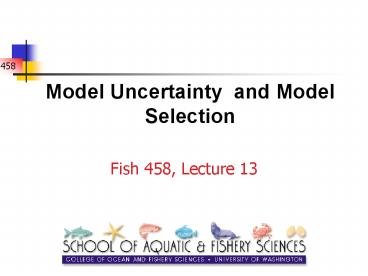Model Uncertainty and Model Selection - PowerPoint PPT Presentation
1 / 19
Title:
Model Uncertainty and Model Selection
Description:
... of the data series for northern cod should have been used for assessment purposes) ... Back to cod-I. Some alternative hypotheses : ... – PowerPoint PPT presentation
Number of Views:28
Avg rating:3.0/5.0
Title: Model Uncertainty and Model Selection
1
Model Uncertainty and Model Selection
- Fish 458, Lecture 13
2
Overview
- Models are hypotheses regarding how the world
could work. There are usually several competing
models ranging from very simple to very
complicated. - Some important results (e.g. extinction risk do
we have environmental variation in deaths?) will
be sensitive to model structure. - Complex models explain the data better but may
provide poor forecasts. - Classical statistics emphasizes estimation
uncertainty. However, many would argue that model
uncertainty is more important in practice (e.g.
which of the data series for northern cod should
have been used for assessment purposes).
3
Complexity vs Simplicity-I
We wish to approximate a function using a
histogram based on 100 points. How many bins
should we choose?
Too many imprecise. Too few - biased
4
Complexity vs Simplicity-II
- Too few parameters, we cant capture the true
model adequately error due to approximation. - Too many parameters, we cant estimate them
adequately error due to estimation. - The optimal number of parameters depends on the
amount of data.
5
Complexity vs Simplicity-III
- Consider approximating N(100,252) using a
histogram. We define a discrepancy between the
predicted and true distributions using
6
Complexity vs Simplicity-IV
The optimal number of bins increases with N
7
Model Selection
- Model selection can be seen as evaluating the
weight of evidence in favor of each hypothesis
and using this to select among the hypotheses.
8
Model Selection (Nested Models)
- A model is nested within another model if it is a
special case of that model, e.g. - We can compare nested models (model B is nested
within model A) using the likelihood ratio test - R, the likelihood ratio, is ?2 distributed with
number of degrees of freedom equal to the
difference in parameters between models A and B.
9
Back to cod-I
- Some alternative hypotheses
- The Base case model (1) is nested within models 2
and 3. Models 4 and 5 are nested within model 1.
10
Back to cod-II
Log-likelihood (not the negative-log-likelhood)
Models (A/B) 2 difference ?2-critical (0.05)
2/1 34.718 34.448 0.532 3.84
3/1 34.858 34.448 0.820 3.84
1/4 34.448 28.472 11.954 3.84
1/5 34.448 26.973 14.950 21.03
11
Model Selection(non-nested models)
- The likelihood ratio test can only be applied to
compare nested models. However, we often wish to
compare non-nested models. We use the Akaike
Information Criterion (AIC) to make such
comparisons. - We compute the AIC (AICc for small sample sizes)
for each model and choose that which has the
lowest AIC.
12
Model Selection(non-nested models)
- Choose the model with the lowest value of AIC.
- Note that the data, Y, are the same for all
models.
13
Comparing Growth Curves-I
- We wish to compare between the von Bertalanffy
and logistic growth curves for some simulated
data (the true model is the von Bertalanffy
curve). - We generate 100 data sets based on the von
Bertalanffy growth curve for various values for ?
and count the fraction of cases the von
Bertalnffy curve is chosen correctly .
14
Comparing Growth Curves-II
Likelihoods (p4) Von Bert
20.25 Logistic 11.30
CV0.2
15
Comparing Growth Curves-III
- The probability of correctly selecting the von
Bertalanffy growth curve depends on ? (and the
sample size). - Checking the reliability of model selection
methods by simulation is often worth doing.
?
0.1 0.2 0.5 0.75 1.0
0.98 0.96 0.64 0.57 0.52
16
Model Selection Miscellany-I
- All model selection methods are based on the
assumption that the likelihood function is
correct. This may well not be the case. - Neither likelihood ratio nor AIC can be used to
compare models that have different likelihood
functions / use different data. - Check the residuals about the fits to the data
for all models it may be that none of the
models are fitting the data. Model selection
makes little sense if none of the models fit the
data.
17
Model Selection Miscellany - II
- Rejecting models is not always a sensible thing
to do. In some cases (e.g. examining the
consequences of future management actions),
consideration should be given to retaining
complicated models even if they dont provide
significant improvements in fit. - Model averaging (e.g. giving a weight to each
model say proportional to exp(AIC)) allows
consideration of model uncertainty.
18
Model Selection Miscellany - III
- Always plot the fits of the different models.
Even if one model is significantly better than
another, the improved fit may be qualitatively
insubstantial. - Some models that fit the data better do not
provide more realistic results (e.g. estimating
M often leads to values for M of 0). - Likelihood ratio and AIC are frequentist
approaches. Bayesian techniques are also
available for model selection.
19
Readings
- Hilborn and Mangel, Chapter 7
- Haddon, Chapter 3
- Linhart and Zuchini (1986)
- Burnham and Anderson (1998).
- Quinn and Deriso, Section 4.5































